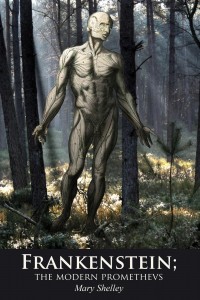 Character:
Character: Frankenstein’s Creature
Source Text: Shelley, Mary Wollstonecraft. Frankenstein, or The Modern Prometheus. New York: Illustrated Editions, 1932. Print.
Entry Author: Claire Tierney
Mary Shelley originally published Frankenstein, or The Modern Prometheus in 1818. The epistolary novel details the story of Dr. Frankenstein as he creates a human made of disparate parts, which he gathers from countless dead bodies. It is possible that he is created from several bodies of different race and ethnicity. Nevertheless, background is undoubtedly mixed, so he is perceived as an outsider and as disturbing. Every character who sees or interacts with the monster is both frightened and disgusted by him, even his creator, who reacts with “breathless horror as disgust filled [his] heart” upon first seeing him(52). His creature soon leaves and the doctor becomes depressed and ill. Meanwhile the creature lives as an outside observer of society, becoming eloquently spoken well-versed in classical literature. He has a human brain; it is his physical appearance which labels him non-human and uncanny.
Frankenstein’s creature is not only mixed with respect to his physicality, but he is also mixed with regard to his identity. Torn between human and nonhuman, he was created “for the sole purpose of infusing life into an inanimate body” (51). He is stuck between two binaries, alive and dead. The doctor’s creature is forced to live on the outskirts of civilization as all who encounter him find him abject and horrific.
After living in solitude for a time, the monster finds his creator and asks nothing more of him than to create a partner so that he could be less lonely. As a mixed character, the monster has no community or others with which to identify. Dr. Frankenstein finds the notion of a female monster to even more terrifying and reviling than his male creation, saying, “shall I create another like yourself, whose joint wickedness might desolate the world?” (151). Frankenstein’s discomfort with a female monster has many implications, including a fear of female sexuality, as well as a fear of the two creature’s reproducing and creating proof of their relations. This discomfort with a complication to the feminine ideal is comparable to society’s discomfort with female mixed race, in that multi-racial women are portrayed to be exotic, yet tamable.The Doctor’s fear of his creature reproducing is also reflective of society’s fear of containing the non-dominant binary, of creating something which cannot be contained. By giving the creature his own life-force, his own ability to create life, he is giving up control of this new “race”.
The Doctor reluctantly agrees, yet never follows through on his promise to create a female. The creature is angered and forced to violence, which impels Dr. Frankenstein to devote his life to the destruction of his creation. He fails in his search, and his creature is last seen by the narrator walking into the cold northern tundra, “lost in darkness and distance” (239).
The title’s allusion to Prometheus compares Dr. Frankenstein’s creature to a heroic figure in Greek mythology responsible for providing humanity with fire, a intellectual and progressive achievement. Prometheus is created from clay, an origin not dissimilar to Frankenstein’s patchwork configuration. His punishment is tragic, as he is to be eternally tortured.
Frankenstein fits the trope of the tragic mulatto, never fitting into any culture, forever an outsider in his own world. Frankenstein suffers because no one is like him. No One exists who is the same as him, physically, culturally, or racially. Frankenstein is a gothic novel, acting as mirror to societal fears of of the unknown, and the abject. Just as humanity repeatedly finds the notion of fellow humans that look and sound different to be threatening, so Frankenstein is perceived as a menace.
 Character: Frankenstein’s Creature
Character: Frankenstein’s Creature
